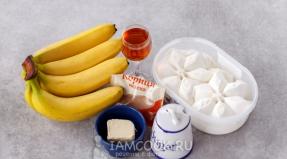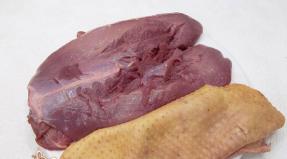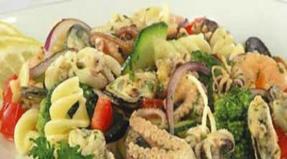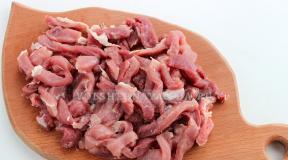Korean salads - the best recipes with photos. How to properly and tasty cook Korean salads
The amazing and mysterious country of Korea. Everything in it is unusual: culture, traditions, and, of course, the national Korean cuisine, which has earned the trust and recognition of gourmets around the world. And what can I say, many of us have long been true fans of her exquisitely spicy dishes. The spiciness of Korean food is historically explained by the fact that most of the dishes were created as seasonings for boiled rice, a very insipid product. This is how attempts to make rice more palatable led to the creation of real culinary masterpieces. Indeed, everything ingenious is simple. Korean salads are the most popular. The combination of vegetables, meat, fruits and spices in salads makes them so original and unique in taste that you definitely want to try them. You can always enjoy real Korean salads in restaurants of national Korean cuisine, and in any market there is always a very large selection of them. But it’s not necessary to spend money on restaurants or buy a ready-made product. You can cook any Korean salads at home, and it's not difficult at all. And you will see for yourself by reading our recipes. Let's treat ourselves and our loved ones to something really spicy.
Korean Salad

Ingredients:
300 g of meat,
2 bulbs
1 head of garlic
2 tbsp vegetable oil,
5 g sesame seeds
1 tsp 9% vinegar,
soy sauce and salt - to taste.
Cooking:
Carefully clean the meat from the films and cut it with a sharp knife into slices up to 5 cm long and 0.5 cm thick. In a hot frying pan with vegetable oil, quickly fry the meat, add soy sauce, chopped onion, salt and continue to fry until until the onion turns golden. Add a little hot water and simmer until the meat is fully cooked. Cool down. In the meantime, prepare the carrots: cut them into strips and lightly salt. Leave for a while, then squeeze the juice from the carrots and mix with the meat, add the garlic, sesame seeds and vinegar.
Korean Saladcauliflower with beans

Ingredients:
1 head of cauliflower,
1 stack beans,
2 raw eggs
½ stack flour,
4 tbsp vegetable oil,
1 tbsp apple cider vinegar
pepper, salt, herbs - to taste.
Cooking:
Boil the beans until cooked, add vinegar and let stand for a day. When it is ready, chop the cabbage into relatively large pieces, dip them in beaten eggs, then in flour and fry in vegetable oil, seasoned well with spices. Then mix the beans and cabbage, sprinkle the dish with herbs on top.
Korean SaladEggplant in Korean

Ingredients:
3 eggplants
2 red bell peppers,
1 large carrot
2 bulbs
garlic, herbs - to taste,
vegetable oil - a little for frying,
1 tbsp salt,
1-2 tbsp 9% vinegar,
ground pepper and ground coriander - also to taste.
Cooking:
Cut the eggplant into strips, sprinkle with salt, mix and leave for 8 hours. Then squeeze and fry in vegetable oil. Also cut the pepper and carrots into strips, onions into half rings, combine these vegetables with eggplant, squeeze out the garlic, add finely chopped greens, season with vinegar, add a little more salt, if necessary, ground black pepper and coriander. Mix well and let the dish brew in the refrigerator for at least 12 hours (the longer, the tastier).
It is hardly possible to confuse the spicy aroma and pungent taste with sourness, which distinguishes all, without exception, Korean salads, with anything else. Korean-style salads have taken a strong position in the holiday menu; you can certainly see them on the menu of most restaurants in the world.
Korean salads are very appetizing and healthy - they owe this to a large number of vegetables and oriental spices that make up their composition. To prepare this cold snack, cooks use various vegetables: carrots, beets, cucumbers, zucchini, eggplant, sweet peppers, onions, white and red cabbage, asparagus beans, celery root, greens. Korean salads may include other additional ingredients: meat, chicken (boiled and smoked), ham, sausage, mushrooms, asparagus, crab sticks, funchose, croutons, squid, potatoes, sea kale.
Korean salads are usually seasoned with vegetable oil - sunflower, corn, sesame. Vinegar (apple or grape) and sometimes soy sauce are also added to the dressing. Thanks to the use of seasonings and a special marinade, Korean salads can be prepared for the future.
The recipe for Korean salads is very simple, so they can be easily prepared at home. The most important thing is to chop vegetables and other components correctly, put all the necessary spices, and also observe some technological subtleties. If you have had a chance to try a Korean salad at least once, its original taste will be remembered for a long time. Without a doubt, these delicious Asian dishes are worth making.
Another salad with Korean spices. This time with fresh broccoli and carrots. We are preparing and trying.
Pickle Korean herring with carrots and tomato paste and enjoy its exotic spicy taste. We offer a simple and versatile recipe that is useful at any time of the year.
Beef tripe can be prepared in many ways, but it tastes best marinated in a Korean-style salad. The cooking process is simple, but requires a sufficient amount of time.
Sometimes you also want to diversify the menu, as well as update your wardrobe. A huge field for creativity is, first of all, salads. Let's cook pickled beans with carrots in Korean.
Making one of the most famous snack salads at home is not difficult at all. Cabbage, peppers, carrots, spices and a little secret from experienced chefs - that's all you need.
From green unripe tomatoes, you can cook a delicious spicy salad with Korean spices. This dish can be prepared for dinner or served at the festive table.
Squid lovers, beware! I propose to cook and enjoy the excellent taste of seafood salad - Korean squid. Delicate, spicy, moderately spicy marinated squids with carrots will surely please you and your...
You have probably met bright bags with interesting dry contents and the name “Asparagus” on the shelves of supermarkets, although this does not even remotely resemble asparagus sprouts. But in reality - this is a semi-finished soy product under ...
Autumn. September. Lines of cars are stretching from summer cottages, loaded with sacks with the main vegetable of our table, our second bread, potatoes. Winter is long, we will cook it, fry it, stew it ... and make salads with it, for example, ...
Zucchini is the most popular vegetable now, its season is in full swing. From it you can cook a lot of delicious and ...
Summer is already in full swing. And with it, the "cucumber" season is approaching, in which you must definitely please yourself and your loved ones with delicious cucumber salads, for example, by preparing cucumbers in Korean. If you live in...
Hye is a type of Korean salad made from raw meat or fish. The main product (meat or fish) is not subjected to heat treatment. They are processed with vinegar, due to which the proteins in meat or fish coagulate. AND...
Without exception, all Korean salads are distinguished by a spicy taste and a spicy aroma that cannot be confused with anything. These snacks have long and firmly occupied one of the main positions on the festive tables, and most restaurants around the world necessarily include them in the menu. Due to the fact that Korean salads contain a lot of spices and vegetables, they become very healthy and very appetizing. Anyone who has ever tried Korean-style vegetables, the recipes of which are very diverse, will remember their unique taste and aroma for a long time.
General principles of preparation
Korean salads are prepared using various vegetables: beets, carrots, zucchini, sweet peppers, cucumbers, asparagus beans, celery root, cabbage of any variety, eggplant, onions, greens. Korean salads are often prepared with the addition of other additional ingredients: different types of meat, smoked or boiled chicken, fish or squid, ham or sausage, crab sticks, asparagus, funchose, any mushrooms, seaweed, potatoes, and crackers.
The most important thing here is the correct cutting of vegetables and other ingredients, the use of the necessary seasonings and spices, as well as observance of some technological subtleties. Vegetable oils are mainly used as dressings for salads in Korean: corn, sesame or ordinary sunflower. It is thanks to the use of special marinades and seasonings that housewives can make almost any Korean preparations for the winter.
Best Recipes
Almost all Korean salad recipes are very simple, so even a novice hostess can cook them in her home kitchen. Culinary experts know many recipes for this oriental snack. Below are just a few of them.
Korean carrot
Among the inhabitants of Central Asia, this popular spicy snack is known as "carrot", in Russia it is called carrot in Korean. It is on sale in any market or supermarket, you can easily cook it at home.
From the specified amount of carrots, a densely filled jar with a volume of 0.8 liters is obtained.
List of required products:
Step by step preparation:

Store the finished snack in the refrigerator, tightly closing the container.
Carrots: recipe 2
This recipe differs from the one described above in that the oil is saturated not only with the aroma of onions, but also with spices. In addition, the salad is prepared with the addition of chili flakes and soy sauce. Carrots are quite spicy, so if you want, you can add less pepper.
List of required components:

Step by step preparation:

Store cooked carrots in the cold in a tightly closed container. A salad that has been aged for about 48 hours has a richer flavor, so it's best to prepare it ahead of time.
Snack of carrots for the winter
This is one of the most successful options for how to cook Korean carrot salad for the winter. This fragrant, moderately spicy, crispy and juicy appetizer will undoubtedly become a welcome guest on any table.
Required products:

Step by step preparation:

After a day, clean the blanks in a cold place where they can be stored for 10 months. Such carrots are suitable for serving as a regular snack, or you can use them in more complex salads or hot dishes.
Cabbage salad
The process of preparing cabbage salad in Korean for the winter is quite simple, but the result is a very juicy and tasty dish for the winter table. In addition, it is very useful in the cold season, because all the vitamins and nutrients are preserved in cabbage and bell pepper.
Required products:

Step by step preparation:

Eggplant preparation
This snack can be considered dietary, because the preliminary preparation of eggplant, unlike most recipes, does not require frying. As a result, vegetables are very tender, juicy and fleshy. e. You can make a snack both spicy and not very, it is enough to add, respectively, more or less garlic and hot spices.
Required products:

Step by step preparation:

Store the Korean-style eggplant appetizer in a cool place. As a result, in winter, you and your family will be happy to enjoy a fragrant and moderately spicy dish.
As you can see, preparing Korean appetizers is quite simple. If desired, you can add or remove various components to any dish, discovering something new. You and your family will surely enjoy these savory snacks, becoming a welcome addition to any table.
Bon Appetit!
Attention, only TODAY!
Korean salads, despite their spiciness and specificity, have gained incredibly great popularity in different countries of the world. Today it is hard to imagine that once our hostesses could do without Korean carrots or vegetables, because they are the basis for many dishes with which we will delight our guests.
Korean salads are prepared not only from raw, but also from pickled, pickled and boiled vegetables. The main components of the salad are often supplemented with mushrooms, fish or meat.
The main secret of oriental salads is hot spices and soy sauce. For example, the specific taste of Korean carrots is created using red peppers, which are roasted over a fire and then quickly cooled. Without heat treatment, such pepper would be almost unsuitable for European food, but the thermal effect "eats" the hotness and adapts the pepper to European taste.
Korean salads - food preparation
When preparing Korean salads, be prepared for the fact that the preparation of products will take a long time. To speed up this process, it is better to get a special grater or slicer in advance (usually, food processors include an element for cutting Korean carrots). If you don't have a grater, learn how to cut carrots into thin, long strips.
Before chopping, hold the vegetable for several hours in cold water, in which case it will become much easier to work with it. It is important that the vegetables are cut into equal pieces or strips, in which case they will marinate or fry evenly.
In no case do not leave carrots or other pickled vegetables in enameled dishes, the taste of metal will be transferred to the products, which certainly will not decorate the dish.
Recipe 1: Korean Carrot
Korean carrots are an excellent appetizer, a side dish for meat, and an ingredient in many salads.
Ingredients:
- 1 kilogram of carrots;
- 4 cloves of garlic;
- 1 teaspoon of coriander;
- 1 tablespoon of vinegar;
- 1 tablespoon of salt;
- ground black pepper;
- red ground pepper;
- vegetable oil;
- water.
Cooking method
Three carrots on a grater. We prepare dressing for a vegetable: 6 tablespoons of water, finely chopped garlic, vinegar, salt, pepper (red and black), coriander, vegetable oil, boil, mix with carrots, put in the refrigerator for 1-1.5 hours.
Carrots in Korean are ready!
Recipe 2: Korean Beets
Korean beetroot is a great snack, it is easy to prepare and also quickly disappears from the festive table.
Ingredients:
- 500 grams of red sweet beets;
- 3 cloves of garlic;
- 100 grams of vegetable oil;
- 70 milliliters of vinegar;
- 1 teaspoon ground coriander;
- 1/2 teaspoon red pepper;
- 1/2 teaspoon monosodium glutamate flavor enhancer;
- salt.
Cooking method
Three beets on a grater. Finely chop the garlic or pass through the garlic, add to the beets, put vinegar and salt. The vegetable should be put in a container so that you can make a water bath, cook for half an hour. Remove from heat and add remaining seasonings. We heat the vegetable oil (no need to boil!), Pour the beets with it. We put the beets in Korean under oppression and hold for a day.
Recipe 3: Korean Vegetables
A wonderful salad that will complement the festive table in winter and summer.
Ingredients:
- 1.5 kilograms of white cabbage;
- 1.5 kilograms of carrots;
- 1 kilogram of bell pepper;
- 1 kilogram of onion;
- 2 heads of garlic;
- 1 teaspoon of black pepper;
- 1 teaspoon red pepper;
- 2 packs of seasoning for Korean carrots;
- 1 piece of hot pepper;
- 6 tablespoons of sugar;
- 1 glass of vegetable oil;
- 1 glass of vinegar;
- 2.5 tablespoons of salt.
Cooking method
We rub the vegetables on a grater, chop, cut into strips. Add salt, sugar, pepper (red and black), vinegar, seasoning for carrots. Pour vegetable oil (1 cup) into a frying pan, fry finely chopped onion on it. Twists garlic and capsicum through a meat grinder. We mix all the ingredients. Lettuce can be eaten immediately or rolled up in jars and tasted great in winter.
Recipe 4: Korean Kadi Heh Salad
Traditional Korean dish.
Ingredients:
- 800 grams of eggplant;
- 1/2 kilogram of cucumbers;
- 300 grams of tomato;
- 3 bell peppers;
- 1 onion;
- 4 cloves of garlic;
- 1 spicy red pepper;
- 1 tablespoon of soy sauce;
- 1/2 cup vegetable oil;
- 1/2 teaspoon ground black pepper;
- 1/2 teaspoon red ground pepper;
- a few drops of vinegar;
- greenery;
- salt.
Cooking method
Cut the eggplant into 2-4 parts, boil for several minutes in salted water (it is very important not to overcook). Move the eggplants from hot water to cold water, let stand for a few minutes, squeeze. We cut the boiled eggplants into small cubes, add chopped onions, bell peppers, tomatoes, cucumbers, put chopped garlic, herbs, spices, soy sauce, vegetable oil and vinegar.
Carrots for Korean salads need to be taken fresh and fairly large (make sure that it is not “wooden”). If chicken is used in the dish, it should be boiled and disassembled into fibers. Wash parsley for salads with warm water, not cold, so it retains its flavor better.
Korean cuisine
Korean cuisine differs from many others in its spicy dishes. And if the question arises of how to cook a spicy salad, then first of all you should pay attention to Korean salads. The main feature is the use of a very large number of spices, especially red pepper. Many dishes have a reddish-brown color precisely because of the abundant presence of red pepper.
The use of pepper is intertwined with the history of the country and its geographical position. The climate in the country is very humid, and pepper is a remedy that has always helped to increase the shelf life of products since the 16th century, when pepper first came to the territory of present-day Korea from Portugal.
In addition to pepper, it is abundantly used as a seasoning - soy sauce (quite popular in our area), twejang and gochujang (you can hardly find these seasonings on the shelves of our stores)
More detailed information can be found in the Internet encyclopedia at the following link - WikiPedia
Carrot in Korean
The most popular spicy salad recipe is Korean carrots. There are many different recipes for this salad. In another way, this salad is called - "Koryo-saram" (which means Soviet Koreans in translation). The salad itself originated from the Kimchi dish. such a salad began to be made on the territory of the USSR, this was due to the fact that on the territory of the Soviet Union it was difficult to get Beijing cabbage, which was replaced with finely chopped carrots. Time passed, and carrots completely replaced cabbage. And now spicy carrots are a direct association with Korean spicy salad.
We will look at one of the classic recipes, but keep in mind that other ingredients can be added to the salad, such as smoked chicken, meat, even sausage, if you like it.
To prepare a classic recipe, we need:
- Carrot
- Garlic
- Seasonings, incl. Red pepper
- Sunflower oil
- Acetic essence or 3% vinegar solution
- Wash and clean carrots. Then we take a grater and rub it into small pieces (other types can be used, for example, it is popular to rub carrots in the form of long threads, a special grater is also used for this)
- Place the grated carrots on a plate. Finely chop the garlic, or use a garlic squeezer
- Add seasonings, salt and red pepper, focus on your taste.
- We take a 3% vinegar solution (about two tablespoons). If you have vinegar essence, then dilute it to 3%. Gently pour over the contents of the plate.
- We take sunflower oil, heat it over low heat and pour everything into a plate. Then mix gently and refrigerate for at least 10-15 minutes.
Korean cabbage
The next classic salad in Korean cuisine is pickled vegetable salad (mostly cabbage). In another way, this dish is called “Kimchi” or simply spicy cabbage. Red pepper, onion, ginger and garlic are added to the salad. As the main ingredient I use cabbage (most often Beijing cabbage), with the addition of radish, which is also in other cases replaced with other vegetable fruits - cucumbers, eggplants, etc.
Of the beneficial properties, a dietary effect can be distinguished - lettuce promotes the breakdown of body fat. Can be used as a prophylactic against colds.
And by the way, it helps a lot in the morning, after a heavy libation of alcohol)
If we consider Korean cabbage recipes, then we can single out a classic recipe that is common in the territory of the post-Soviet states.
- Beijing cabbage (or ordinary for lack of the first)
- garlic, 5-6 cloves
- hot pepper, ground
- sugar
Step by step recipe
- Take a head of cabbage and remove the top layers. We only want juicy and crispy layers
- After cleaning, rinse and cut the head of cabbage into 4 even parts. We put everything in a saucepan. It is better to take an enamel pan. Consider this nuance - combinations of a large amount of garlic, seasonings - create a certain smell that is simply absorbed into the plastic. Therefore, if you decide to use plastic containers, consider this point.
- We take a plate, pour hot water into it, add salt and stir it all.
- As soon as the salt dissolves and the solution cools down, pour it all into a bowl with cabbage.
- All this is covered with a plate so that the contents of the dishes are pressed into the brine. Leaves to salt for 9-11 hours, you can put in the refrigerator. You can stir occasionally so that the leaves are salted evenly.
- We take hot ground pepper (red, or special Korean in the form of flakes). It all depends on your taste, usually put 2-3 tablespoons.
- We take the garlic, peel it and squeeze it into the pepper, add a little sugar (a teaspoon without a handful). All this is poured with water and mixed. You should get a thick porridge.
- Add the resulting porridge to the already salted cabbage. Mix everything thoroughly, each leaf should be smeared with a seasoning mixture. Please note that it is better to do this with gloves, the mixture is thermonuclear.
- We put it under oppression for 1-2 days, so that the cabbage is soaked and the brine stands out.
Heh in Korean
Another popular Korean dish is hye. This is considered both a salad and an appetizer at the same time. For lovers of spicy and spicy dishes who have never tried heh, we recommend that you definitely try it. Unlike Korean carrots, this dish is really very popular in Korea and can be found in any diner.
It is prepared from fish, meat or chicken. The history of the dish has its roots in China. Khwe, a dish made from raw fish and meat, was popular in Kita until the 11th century, but soon the dish disappeared and lost its popularity due to outbreaks of epidemics.
Historical fact - it was one of the favorite dishes of Confucius.
Nowadays, the classic heh is marinated fish dishes. The fish is not processed thermally, but only marinated. I also use meat - beef, lamb or chicken. Pork is considered unsuitable for this dish and is never used.
In our country, they try to process the meat thermally, to prevent poisoning, which ultimately does not affect the quality and taste, and it’s easier to eat processed foods.
How to cook heh at home? It is actually very simple, the main thing is to follow all the steps described in the recipes. We offer you several cooking options.
fish heh recipe
You will need:
- Approximately 400-500 grams of fish fillet (you can take almost any fish - pike perch, carp, catfish, montay, etc.)
- two carrots
- 4 bulbs
- 2 garlic cloves
- Vinegar essence (1 tablespoon)
- Bell pepper
- Spices
- Greenery
- Coriander
- Sugar
Step-by-step instruction:

This is one of many recipes. You can look at the relevant categories on our website to find other recipes.
Meat heh recipe
Khe can be made from beef, poultry, or lamb meat. Below is one of many recipes.
To prepare over you will need:
- 600 grams of beef
- 150 grams of orange juice
- Tomato paste - 2 tablespoons
- 50 grams of bell pepper
- 1 small onion
- Spices
- Dill
- Parsley
- Ground pepper
We follow the following instructions:

This is a safe recipe for cooking heh, heat treatment of meat.
Homemade Chicken Heh Recipe
Chicken is perfect for this dish.
For cooking we need:
- 400 grams of chicken fillet.
- 120 grams of vegetable oil
- 2-3 bulbs
- 2-3 carrots
- Acetic essence, or 9% acetic solution
- Ground pepper
- Spices (you can use special ready-made seasonings for Korean cuisine)
Step by step cooking recipe:
- Chicken cut into thin strips
- We rub the carrots on a grater, you should get long slices
- Peel the onion and cut it into half rings
- We take a frying pan, pour vegetable oil on it and heat it
- Pour the chopped chicken with hot oil, add carrots and onions on top. Pour vinegar on top, add all the spices and salt (to taste) and mix thoroughly.
- The dish should stand in a cool place for at least a day (preferably in the refrigerator)
Dishes must be enameled or plastic, because. we use vinegar.

It is best to take slightly frozen chicken breast. If the meat is frozen, then it is easier to cut it neatly. Also note that spices are added only after the oil has been poured. This allows you to keep all the flavor of the spices.
As you can see, cooking heh at home is not so difficult.
If you have any comments, please leave them at the bottom of the page.
I wish you success.
The original list of Korean dishes, without recipes - you can see


















